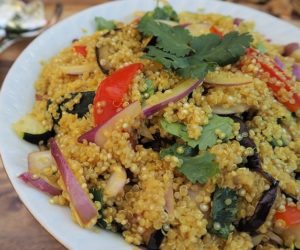A happy, healthy gut is important to your overall health. The gut is made up of the gastrointestinal (GI) tract and includes your stomach and your small and large intestines. The gut is responsible for digesting food, absorbing nutrients, and eliminating waste. Living within these organs and helping with these activities is a vast array of over a 1,000 different species of microorganisms. These organisms can weigh a whopping 3 to 5 pounds per person.
Microbes and your Body
More than 10 trillion cells make up the human body. That may seem like a lot, but those cells are outnumbered 10 to 1 by tiny organisms called microbes! The most common microbe in the body is called bacteria. These teeny critters are made up of a single cell. They are so small that thousands could fit in the period at the end of this sentence.
Benefits of Gut Health
The microorganisms in our gut help us in many different ways. They:
- Improve our immune system: Microbes help to train our immune cells early in life to distinguish between helpful and harmful microorganisms.
- Help with nutrient absorption: When the stomach and small intestine are unable to digest certain foods we eat, our gut microbes jump in to offer a helping hand, ensuring we get the nutrients we need.
- Provide physical protection: Microbes secrete a protective mucus that lines the intestine to form a protective barrier. Other microbes then colonize this layer and exclude harmful bacteria from latching on. Finally, other microbes produce natural antibiotic compounds that can kill foreign microbes. Other microbes secrete an acidic compound that makes the gut less hospitable.
- Support function of the GI tract: Microbes contribute to the formation of new cells in the intestine. They also move food down the gut.
Maintaining the right diversity of microorganisms in your gut is important. Also the mix of microorganisms in your gut can be impacted by diet, inflammation, illness, stress, and antibiotic use. Therefore, an imbalance in your gut can result in diarrhea, abdominal pains, and cramping.
Recipe for Health
Good bacteria are supported by healthy, whole, plant-based foods high in fiber. Try including more plant-based, high fiber ingredients in your meals including whole grains, fruits, vegetables, and legumes. What types of foods do you like that will support healthy gut microbes?
An example of how to incorporate more plant based food into your healthy eating plan is a one-bowl meal filled to the brim with vibrant colors, wholesome veggies, and plant based proteins. This meal combines healthful foods that vary in flavor, texture, and nutrients. Because it comes down to mixing and matching, there are endless combinations of grains, proteins, vegetables, and sauces. Get your inspiration from a variety of cuisines, featuring different seasonal vegetables, or make it all about the sauce.
Putting together the bowls is a great way to get the family or friends involved. Organize the toppings in small bowls. Invite your family or friends to grab a bowl, put some grains in the bottom and then layer up the toppings.
- Grain – Start with a base of whole grains. Try brown rice, quinoa, couscous, rice noodles, barley, or farro. Grains provide protein, fiber, and healthy carbs.
- Protein – Proteins can be in the form of tofu, tempeh, edamame, chickpeas, avocados, a fried egg, or lean meats like chicken or fish.
- Vegetables, fruits, and herbs – Fresh, sautéed, or roasted vegetables. Try mixing textures. Consider adding mango, kiwi, or pomegranates.
- Fermented foods – Consider using fermented ingredients like soy sauce, miso, tempeh, yogurt, kimchi, sauerkraut, or fermented soybeans. Fermented foods contain healthy microbes that can improve and balance gut health.
- Dressing – Peanut, tahini or miso dressing.

Sesame Miso Dressing
- 3 tbsp. toasted sesame oil
- 2 tbsp. miso
- 2 tbsp. water
- 1 tbsp. soy sauce
- 1 tbsp. maple syrup
- 1 tbsp. apple cider vinegar
- 1 tbsp. sesame seeds
- 1″ fresh ginger, grated
- juice of one lime
In a small bowl combine all the ingredients for the dressing and shake vigorously until well combined. Place in the refrigerator and use within 3 or 4 days.

